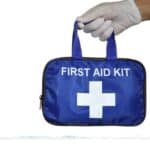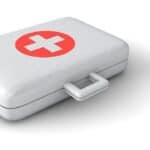
If you have the misfortune that your cat has suffered an accident, a fall, has been burned, has been poisoned or has received an electric shock, you should go immediately to the veterinarian or a pet hospital. In the meantime, it’s vital that you can give your feline pet first aid to help it survive. At Petlifey, we explain what you should do.
What is first aid?

First aid means assistance provided before professional help can be obtained.
It must be administered calmly, quickly and efficiently. You should have a feline first aid kit at home, and you should take it with you whenever your cat travels with you.
The first aid kit should contain antiseptic cream for first aid, sterile gauze, sterilized cotton, hydrogen peroxide (hydrogen peroxide), bandages, tape, tweezers, scissors and mineral oil. A blanket and flashlight might also be helpful.
You will notice that these items are necessary both at home and in the car anyway. If you, a family member, or a guest needed medical assistance, you’d be prepared.
Remember that the better an injured part is treated before enlisting the help of a veterinarian, the greater the chances of an early recovery of the patient.
A cat that has suffered a major fall should first receive artificial respiration if necessary, and then be treated to stop bleeding or to repair possible fractures. A veterinarian should be contacted immediately as soon as the animal has received first aid.
Artificial respiration to a cat
If you find yourself in the need to resuscitate a cat, you will have to act quickly since a delay of even a few minutes in getting the animal to breathe again would cause irreversible brain damage.
There are two forms of artificial respiration suitable for a cat and require the same initial preparation :
- First clean the mouth and throat of mucus, food or any other matter.
- Then grab and stick the cat’s tongue out; This will be easier if you hold it with a piece of cloth, such as your handkerchief or your shirt.
Mouth-to-mouth
- Mouth-to-mouth resuscitation is simple, fast, and efficient. Inhale deeply, cover the cat’s nose and muzzle with your mouth and one hand, and exhale into the muzzle.
- Remember that you are not blowing up a balloon and that a cat’s lung capacity is not as great as ours.
- You may need to repeat this several times and after exhaling into the cat’s muzzle you may need to press firmly behind his elbows to get them to breathe.
The pressure method
- Push firmly behind the elbow for three seconds; This compresses the lungs.
- Loosen for three seconds and continue until the cat begins to breathe on its own. Then continue helping it by applying pressure in sync with the animal’s own breathing until it seems to feel better.
- Keep the animal warm with a blanket or, if you don’t have one, a coat, jacket, or shirt after the cat has begun to breathe normally. Contact a vet to find out what to do next.
Bleeding in cats
Bleeding can come from an artery, vein, or capillary vessel. Blood loss has to stop as quickly as possible. If you see blood gushing out of a wound or at regular intervals (with each heartbeat), an artery has been cut.
This is the most serious of bleeding and you will need to apply a tourniquet to stop it.
How to make a tourniquet on a cat
- Use a piece of cloth, such as a handkerchief. Don’t waste time looking for something suitable; tear up your shirt or t-shirt if necessary, but act as fast as possible .
- The fabric must be tied loosely, tightening it with the help of a stick. If you can’t find a stick, use a pencil or pen, or finally just twist the fabric with your hand.
- Apply the tourniquet as close to the wound as possible, and on the side closest to the heart.
- The tourniquet needs to be tight enough to control the bleeding, but not more than that.
- Leave the tourniquet for about eight minutes or so, and then loosen it for three to four minutes.
Every time you have had to apply a tourniquet you will have to see the vet. If you are alone with the cat you will have to call it yourself. It is a good idea to have someone help you so that you can keep the animal all the time, until the doctor arrives.
Any arterial bleeding you need to treat is likely to have occurred in one of the extremities. This is fortunate, as it is not possible to apply a tourniquet to the neck or body .
If an arterial injury occurs in any of these areas you will have to resort to the compression method described below to control the wound and then you will have to call a veterinarian for help.
Bleeding in a vein or capillary
Blood drips or runs regularly from a vein or capillary is easier to control a bleeding ar-terial :
- Apply firm pressure to the area with a clean cloth. Tear up a piece of clothing if necessary, but don’t waste time searching for bandage material.
- Hold the makeshift compress for several minutes on the wound and release it
- You should notice that the blood flow has been noticeably reduced.
One or two applications of pressure should suffice; If the bleeding does not reduce, you will need to bandage the area and contact a veterinarian for help.
Shock in cats
The shock is the result of one reduced irrigation blood to the brain. The symp-mas include diminished pulses of the heart, a reduction in body temperature and hyperventilation .
Clear the mouth and throat of any obstructions to clear the windpipe. The most common obstruction is the tongue. Then stop any bleeding that has occurred as we explained in the previous point.
Keep the cat warm and slightly raise the back of the body so that the head is lower than the heart. Then quickly contact a veterinarian to continue with the appropriate treatment.
If the shock is electrical in nature, do not touch the animal until you have disconnected the current that caused the shock. Failure to do this could electrocute yourself too.
Give artificial respiration if necessary, treat the cat as in the case of a non-electric shock, and contact a veterinarian immediately.
Wound care in cats
The first thing to do is stop all bleeding. Then you must follow the following steps:
- To avoid possible infections, thoroughly clean the area with warm soapy water, hydrogen peroxide (hydrogen peroxide), or an antibacterial solution.
- Bandage a non-adherent sterile patch in contact with the skin and place a gauze pad over it.
- Secure the bandage with tape, taking care not to over-tighten. To keep the bandage from shifting, put tape over adjacent fur-covered areas. We repeat, if you cannot find the necessary materials, use what you have on hand until later, when you have the opportunity to redo what is necessary.
- If the wound is severe, either very large or very deep, temporarily tape the wound edges together before bandaging. These wounds require the care of a veterinarian.
The cuts in the cushions or paw pads must be very well washed, checking that there are no foreign matter in the wound before bandaging. Many leg injuries are caused by pieces of glass.
If after a while appreciable swelling persists in the wound area, it is possible that a pocket of pus has formed that will have to be punctured and cleaned .
The wounds caused by sharp objects, like the anima-les bites, must be observed very carefully. In these deep wounds abscesses usually form in which pus can accumulate. Inflammation around the wound indicates an infection and if this happens a vet will need to examine the wound.
The pellet wounds, causing bleeding and shock, requiring first aid and naturally need further care of a veterinarian.
The abscess pus can be totally or partially removing the crust and allowing oozing wound. Clean the area well and keep the wound open. Don’t let a scab reappear until the infection has cleared.
Fractures in cats
A vet will have to handle a broken bone ; what you have to do is protect the affected area and take the cat to the vet quickly.
There can be two types of fractures: open fracture or closed fracture. We explain how to act:
How to deal with an open fracture of a cat
If the fractured bone protrudes from the skin (compound or open fracture), do not move the animal, because a blood vessel, muscle or nerve tissue could break.
How to deal with a closed fracture of a cat
If you suspect that there is a fracture but can not check (single or closed fracture), you can splint.
- Use a sturdy material; wood is best, but if necessary a thick newspaper will suffice.
- Put a splint on each side of the fracture and wrap it with tape, tape, or bandages.
- Don’t over-tighten the bandages, but put them tight enough that the splint won’t come off easily.
- As soon as possible, have your vet examine the fracture by X-ray so that he can determine the best way to repair the fracture.
How to Transfer an Injured Cat
It is best to move the cat on a stretcher, which may consist of a simple wooden board, a piece of thick cardboard, or a buttoned shirt with two sticks (mop handles) threaded through the sleeves and body.
Before moving an injured animal, examine it for bleeding, breathing difficulties, shock, or fractures. Always address these potential disorders before doing anything else.
Heat stroke (Thermal prostration)
One of the most common causes of heat damage in cats is being locked in a car without proper ventilation. The indoor temperature rises rapidly, perhaps up to 15-20 degrees higher than the outdoor temperature.
A less common cause of heat prostration in felines is inadvertently locking the animal in a closet or attic. Signs or symptoms of this disorder include panting, foam at the muzzle, or collapse .
In these cases, cool the cat gradually with water. Take her temperature regularly, about every five minutes. If the animal is comatose, reduce its temperature as indicated above and take it quickly to the vet.
Burns in cats
It is fortunate that most cat burns occur on their paws, because these burns are the easiest to treat, whether they were caused by fire or by chemicals .
A common cause of foot pad burns is contact with the still hot plates of an electric stove. How you should act:
- Should put the pa- ta burned in cold water for about twenty minutes .
- Afterwards you have to apply abundant first aid cream
- Then apply a non-adhesive patch on the burned area, making sure that it is well covered.
- Complete the bandage of the entire area with patches and tape.
- Because the burned tissue swells, do not over-tighten the bandage.
- The bandages will have to be changed periodically and you will have to ask your vet for help.
In cases of severe or extensive burns, get professional help as quickly as possible as soon as first aid has been given to the injured animal.
Poisoning a cat
The most common causes of poisoning cats are plants and products QUI-monkeys. Since almost all common household plants are poisonous to cats, it is best if you have cats, not to have plants.
Some of the most common toxic chemicals are found in insecticides, fungicides, herbicides, poisons for rats, snails and slugs, and cleaning products .
You can help prevent accidental poisoning of your cat (and also your children) by keeping these substances well stored in an inaccessible and safe place. Prevention is the best defense against accidental poisoning.
Common symptoms of poisoning include vomiting, uncoordinated movements, and seizures .
It is very difficult to treat a poisoning without knowing what caused it. You will have to call the vet. If you know the substance that has poisoned your cat, let your vet know right away, as they may be able to tell you what first aid to apply before the cat reaches their hands.
Other accidents in cats
Apart from everything mentioned above, there are a lot of problems and accidents that your cat can suffer.
We explain the most common ones, how you should act and the necessary first aid:
My cat has nailed a hook
A hook hooked near the eye has to be removed by a veterinarian; in other places, you can probably remove it (except, of course, if it is stuck in the throat).
Push the hook through the skin, until the barb pokes out. Cut the rod with a pair of pliers, or you may be able to cut it with a pair of scissors if you place the hook close to the axis of the blades, where you can apply more force. This will remove the pick. Remove the hook. Treat the wound to the same treatment as any other puncture wound .
My cat swallowed a needle
If you see a thread coming out of your cat’s snout, don’t pull it. It is very possible that a needle has been swallowed and that it has been stuck in the throat or even in the stomach of the feline. Look inside the cat’s snout; If you can see the other end of the thread, then obviously there is no problem, but if not, suspect the worst.
Call your vet, who will likely X-ray the cat to determine exactly where the needle is, before attempting to remove it. Avoid these types of problems by ensuring that your sewing utensils are always well stored in a safe place.
My cat has frozen
Frostbite in a cat usually occurs on the feet, ears, or tail. With a towel or cloth, apply moist heat to the affected area and repeat the operation frequently. Dry the affected area and protect it with non-adhesive bandages.
My cat has encountered a skunk
An encounter with a skunk or skunk is rarely fun for a feline. Wash it with tomatoes or tomato juice and then bathe it with soap and water. After this much of the odor will have been removed, although something is likely to persist for a time.
My cat has met a porcupine or a hedgehog
If your cat bumps into a porcupine, the situation is difficult. Every thorn has to be removed, and this is painful. For this reason, entrust the operation to your veterinarian, since the cat may need to be anesthetized.






